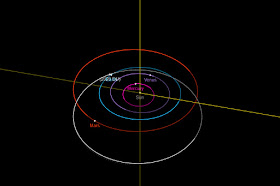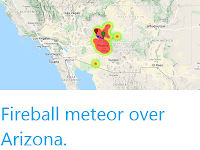Asteroid 2020 DU passed by the Earth at a distance of about 324 900
km (0.85 times the average distance between the Earth and the Moon, or
0.22% of the distance between the Earth and the Sun), slightly before 1.20 pm
GMT on Thursday 13 February 2020. There was no danger of
the asteroid hitting us, though were it to do so it would not have
presented a significant threat. 2020 DU has an estimated
equivalent
diameter of 3-11 m (i.e. it is estimated that a spherical object
with
the same volume would be 3-11 m in diameter), and an object of this
size
would be expected to explode in
an airburst (an explosion caused by superheating from friction with the
Earth's atmosphere, which is greater than that caused by simply
falling, due to the orbital momentum of the asteroid) in the atmosphere
more than 30 km above the ground, with only fragmentary material
reaching the Earth's surface.
The calculated orbit of 2020 DU. JPL Small Body Database.
2020 DU was discovered on 16 February 2020 (the day before its closest encounter with the Earth) by the
University of Arizona's Mt. Lemmon Survey at the Steward Observatory on Mount
Lemmon in the Catalina Mountains north of Tucson. The designation 2020 DU
implies that the asteroid was the twentieth object (asteroid A -
in numbering asteroids the letters A-Y, excluding I, are assigned
numbers from 1 to 24, with a number added to the end each time the
alphabet is ended, so that A = 1, A1 = 25, A2 = 49, etc, which means that U = 20) discovered in the second half of February 2020 (period 2020 D).
2020 DU has a 901 day (2.47 year) orbital period, with an elliptical
orbit tilted at
an angle of 1.57° to the plain of the Solar System which takes in to
0.90 AU from the Sun (90% of the distance at which the Earth orbits the
Sun) and out to 2.75 AU (275% of the distance at which the Earth orbits
the sun and almost twice as far from the Sun as the planet Mars). It is therefore classed as
an Apollo Group Asteroid (an asteroid that is on average further from the Sun
than the Earth, but which does get closer).
See also...
Follow Sciency Thoughts on Facebook.







